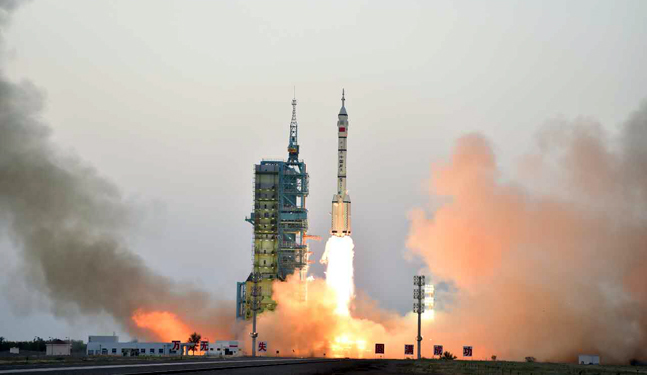China Launches Shenzhou-11 Astronauts to Tiangong-2 Space Lab

WASHINGTON — China successfully launched its first human spaceflight mission in more than three years Oct. 16, placing into orbit a spacecraft carrying two astronauts that will dock with a new space laboratory module.
A Long March 2F spacecraft lifted off from the Jiuquan Satellite Launch Centre at 7:30 p.m. Eastern Oct. 16 (7:30 a.m. Beijing time Oct. 17) and placed the Shenzhou-11 spacecraft into orbit. The spacecraft separated from the rocket's upper stage and deployed its solar panels a little more than 10 minutes after liftoff.
"The rocket is flying according to its original plan, and the Shenzhou spacecraft has entered its preliminary orbit," said Gen. Zhang Youxia, chief commander of China's manned space program, in a statement less than a half-hour after launch. "I announce the launch of Shenzhou-11 manned spacecraft is a complete success." [China's Tiangong-2 Space Lab Mission in Pictures]
On board Shenzhou-11 are astronauts Jing Haipeng and Chen Dong, publicly announced as the crew less than 24 hours before the launch. Jing is a veteran astronaut, having flown on Shenzhou-7 in 2008 and Shenzhou-9 in 2012 . Chen is making his first spaceflight.
Shenzhou-11 is scheduled to dock with the Tiangong-2 module Oct. 18. That module, launched Sept. 15, will host the crew for 30 days, twice as long as the existing Chinese human spaceflight endurance record, set by the Shenzhou-10 mission in June 2013. That mission was also the last Chinese human spaceflight prior to the Shenzhou-11 mission.
During the 30-day mission, Jing and Chen will carry out a number of medical and space science experiments, as well as test various systems on the Tiangong-2 module. They will also engage in public outreach activities, including serving as "special correspondents" for the state-run Xinhua news service.
The mission is part of Chinese efforts to develop a permanent space station. Chinese officials have indicated that they expect this station, consisting of several modules but smaller than the International Space Station, to be completed by the early 2020s.
Get the Space.com Newsletter
Breaking space news, the latest updates on rocket launches, skywatching events and more!
This story was provided by SpaceNews, dedicated to covering all aspects of the space industry.
Join our Space Forums to keep talking space on the latest missions, night sky and more! And if you have a news tip, correction or comment, let us know at: community@space.com.

Jeff Foust is a Senior Staff Writer at SpaceNews, a space industry news magazine and website, where he writes about space policy, commercial spaceflight and other aerospace industry topics. Jeff has a Ph.D. in planetary sciences from the Massachusetts Institute of Technology and earned a bachelor's degree in geophysics and planetary science from the California Institute of Technology. You can see Jeff's latest projects by following him on Twitter.











